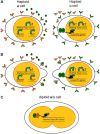An Overview of the Function and Maintenance of Sexual Reproduction in Dikaryotic Fungi
- PMID: 29619017
- PMCID: PMC5871698
- DOI: 10.3389/fmicb.2018.00503
An Overview of the Function and Maintenance of Sexual Reproduction in Dikaryotic Fungi
Abstract
Sexual reproduction likely evolved as protection from environmental stresses, specifically, to repair DNA damage, often via homologous recombination. In higher eukaryotes, meiosis and the production of gametes with allelic combinations different from parental type provides the side effect of increased genetic variation. In fungi it appears that while the maintenance of meiosis is paramount for success, outcrossing is not a driving force. In the subkingdom Dikarya, fungal members are characterized by existence of a dikaryon for extended stages within the life cycle. Such fungi possess functional or, in some cases, relictual, loci that govern sexual reproduction between members of their own species. All mating systems identified so far in the Dikarya employ a pheromone/receptor system for haploid organisms to recognize a compatible mating partner, although the paradigm in the Ascomycota, e.g., Saccharomyces cerevisiae, is that genes for the pheromone precursor and receptor are not found in the mating-type locus but rather are regulated by its products. Similarly, the mating systems in the Ascomycota are bipolar, with two non-allelic idiomorphs expressed in cells of opposite mating type. In contrast, for the Basidiomycota, both bipolar and tetrapolar mating systems have been well characterized; further, at least one locus directly encodes the pheromone precursor and the receptor for the pheromone of a different mating type, while a separate locus encodes proteins that may regulate the first locus and/or additional genes required for downstream events. Heterozygosity at both of two unlinked loci is required for cells to productively mate in tetrapolar systems, whereas in bipolar systems the two loci are tightly linked. Finally, a trade-off exists in wild fungal populations between sexual reproduction and the associated costs, with adverse conditions leading to mating. For fungal mammal pathogens, the products of sexual reproduction can be targets for the host immune system. The opposite appears true for phytopathogenic fungi, where mating and pathogenicity are inextricably linked. Here, we explore, compare, and contrast different strategies used among the Dikarya, both saprophytic and pathogenic fungi, and highlight differences between pathogens of mammals and pathogens of plants, providing context for selective pressures acting on this interesting group of fungi.
Keywords: Dikarya; bipolar mating; dimorphic fungi; homeodomain transcription factor; mating type; pheromone/receptor; tetrapolar mating.
Figures





References
-
- Anderson J., Ullrich R. C. (1982). Diploids of Armillaria mellea: synthesis, stability, and mating behavior. Can. J. Bot. 60 432–439. 10.1139/b82-059 - DOI
-
- Asante-Owusu R. N., Banham A. H., Bohnert H. U., Mellor E. J. C., Casselton L. A. (1996). Heterodimerization between two classes of homeodomain proteins in the mushroom Coprinus cinereus brings together potential DNA-binding and activation domains. Gene 172 25–31. 10.1016/0378-1119(96)00177-1 - DOI - PubMed
Publication types
Grants and funding
LinkOut - more resources
Full Text Sources
Other Literature Sources
Molecular Biology Databases

